Asian Pacific Global Spa Market: Competition and Resources
VerifiedAdded on 2020/07/23
|11
|3564
|122
Report
AI Summary
This report provides an in-depth analysis of the Asian Pacific global spa market, focusing on the competitive landscape, particularly within the context of Tamarind Springs Forest Spa in Thailand. It examines various strategies for spa competition at a global scale, including branding, competitive advantages, promotional techniques, franchising, and joint ventures. Furthermore, the report delves into the construction and building considerations essential for creating contemporary and sustainable spas, emphasizing aspects like design inspiration, operational considerations, production, facilities, integrated design, site design, indoor environmental quality, and the use of sustainable materials. The report also outlines the types of resources required to establish a successful destination spa, contributing to a comprehensive understanding of the spa industry's dynamics and requirements. This analysis aims to provide valuable insights for businesses seeking to thrive in the competitive spa market.
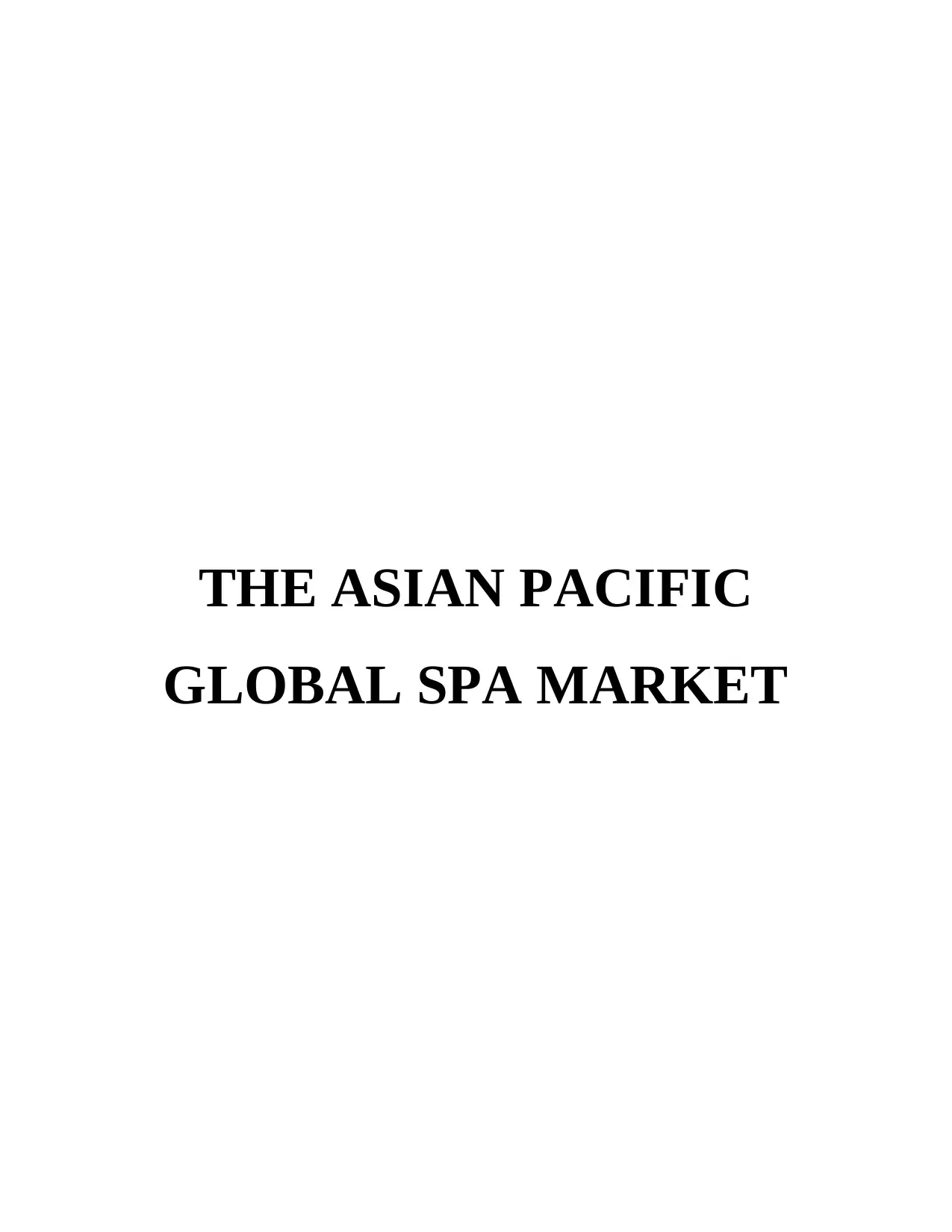
THE ASIAN PACIFIC
GLOBAL SPA MARKET
GLOBAL SPA MARKET
Paraphrase This Document
Need a fresh take? Get an instant paraphrase of this document with our AI Paraphraser
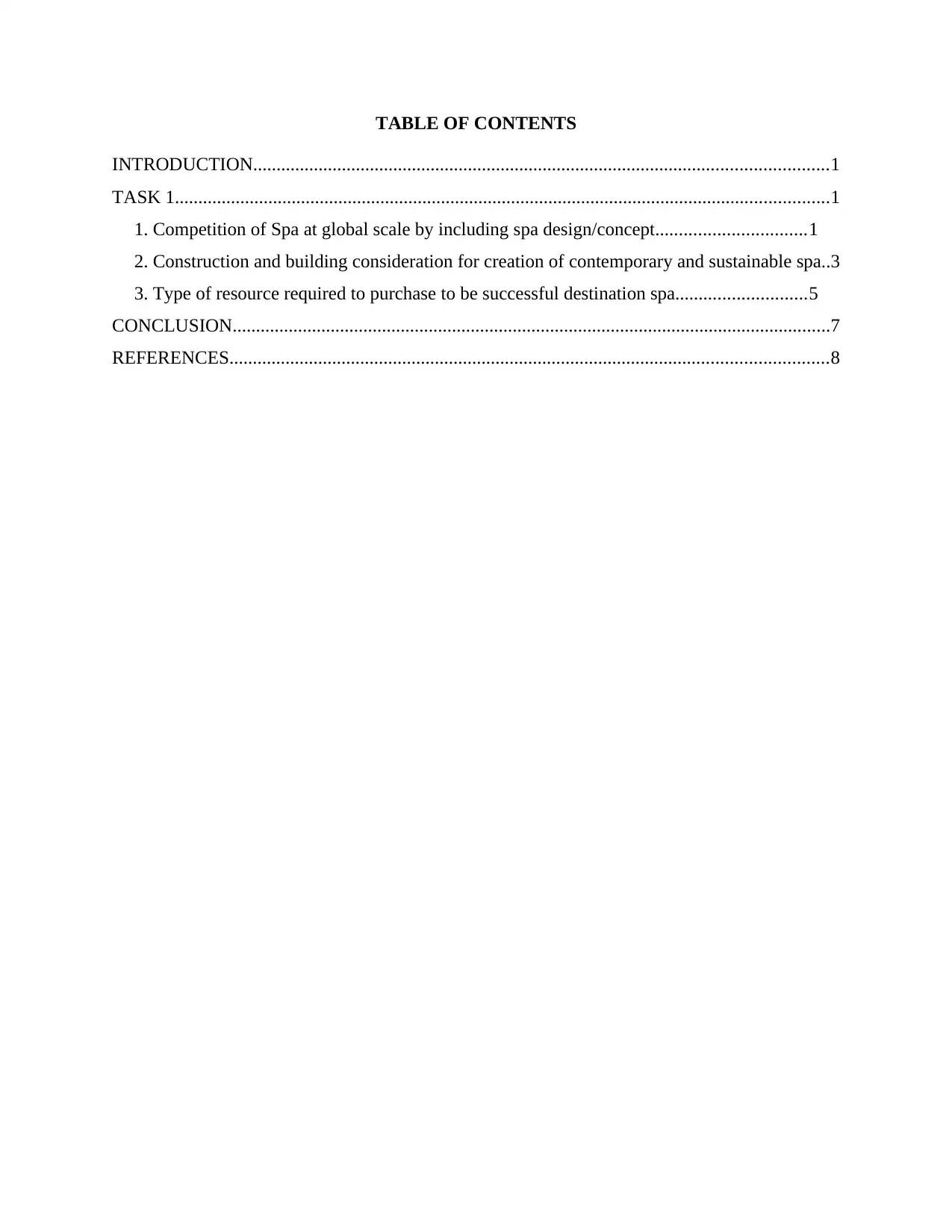
TABLE OF CONTENTS
INTRODUCTION...........................................................................................................................1
TASK 1............................................................................................................................................1
1. Competition of Spa at global scale by including spa design/concept................................1
2. Construction and building consideration for creation of contemporary and sustainable spa..3
3. Type of resource required to purchase to be successful destination spa............................5
CONCLUSION................................................................................................................................7
REFERENCES................................................................................................................................8
INTRODUCTION...........................................................................................................................1
TASK 1............................................................................................................................................1
1. Competition of Spa at global scale by including spa design/concept................................1
2. Construction and building consideration for creation of contemporary and sustainable spa..3
3. Type of resource required to purchase to be successful destination spa............................5
CONCLUSION................................................................................................................................7
REFERENCES................................................................................................................................8
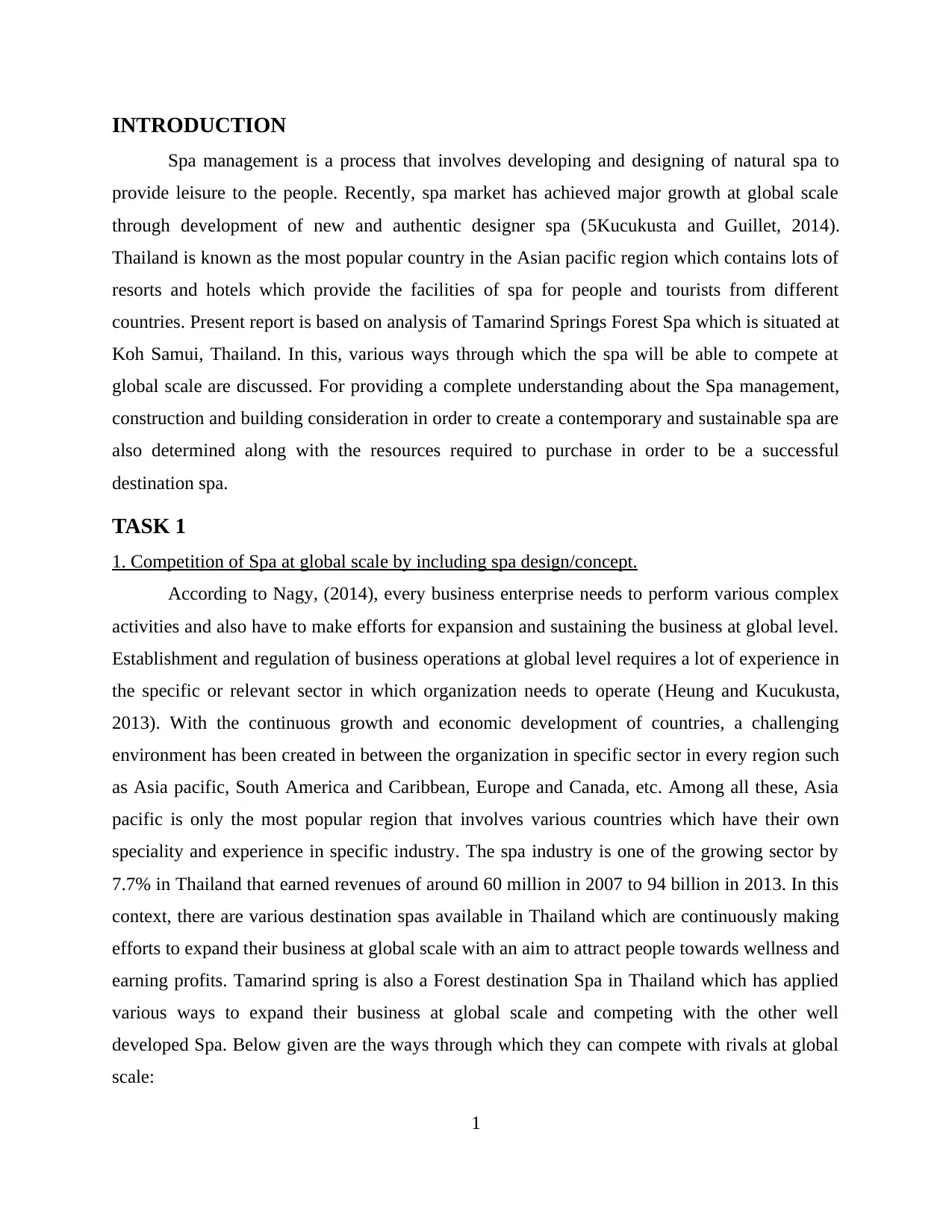
INTRODUCTION
Spa management is a process that involves developing and designing of natural spa to
provide leisure to the people. Recently, spa market has achieved major growth at global scale
through development of new and authentic designer spa (5Kucukusta and Guillet, 2014).
Thailand is known as the most popular country in the Asian pacific region which contains lots of
resorts and hotels which provide the facilities of spa for people and tourists from different
countries. Present report is based on analysis of Tamarind Springs Forest Spa which is situated at
Koh Samui, Thailand. In this, various ways through which the spa will be able to compete at
global scale are discussed. For providing a complete understanding about the Spa management,
construction and building consideration in order to create a contemporary and sustainable spa are
also determined along with the resources required to purchase in order to be a successful
destination spa.
TASK 1
1. Competition of Spa at global scale by including spa design/concept.
According to Nagy, (2014), every business enterprise needs to perform various complex
activities and also have to make efforts for expansion and sustaining the business at global level.
Establishment and regulation of business operations at global level requires a lot of experience in
the specific or relevant sector in which organization needs to operate (Heung and Kucukusta,
2013). With the continuous growth and economic development of countries, a challenging
environment has been created in between the organization in specific sector in every region such
as Asia pacific, South America and Caribbean, Europe and Canada, etc. Among all these, Asia
pacific is only the most popular region that involves various countries which have their own
speciality and experience in specific industry. The spa industry is one of the growing sector by
7.7% in Thailand that earned revenues of around 60 million in 2007 to 94 billion in 2013. In this
context, there are various destination spas available in Thailand which are continuously making
efforts to expand their business at global scale with an aim to attract people towards wellness and
earning profits. Tamarind spring is also a Forest destination Spa in Thailand which has applied
various ways to expand their business at global scale and competing with the other well
developed Spa. Below given are the ways through which they can compete with rivals at global
scale:
1
Spa management is a process that involves developing and designing of natural spa to
provide leisure to the people. Recently, spa market has achieved major growth at global scale
through development of new and authentic designer spa (5Kucukusta and Guillet, 2014).
Thailand is known as the most popular country in the Asian pacific region which contains lots of
resorts and hotels which provide the facilities of spa for people and tourists from different
countries. Present report is based on analysis of Tamarind Springs Forest Spa which is situated at
Koh Samui, Thailand. In this, various ways through which the spa will be able to compete at
global scale are discussed. For providing a complete understanding about the Spa management,
construction and building consideration in order to create a contemporary and sustainable spa are
also determined along with the resources required to purchase in order to be a successful
destination spa.
TASK 1
1. Competition of Spa at global scale by including spa design/concept.
According to Nagy, (2014), every business enterprise needs to perform various complex
activities and also have to make efforts for expansion and sustaining the business at global level.
Establishment and regulation of business operations at global level requires a lot of experience in
the specific or relevant sector in which organization needs to operate (Heung and Kucukusta,
2013). With the continuous growth and economic development of countries, a challenging
environment has been created in between the organization in specific sector in every region such
as Asia pacific, South America and Caribbean, Europe and Canada, etc. Among all these, Asia
pacific is only the most popular region that involves various countries which have their own
speciality and experience in specific industry. The spa industry is one of the growing sector by
7.7% in Thailand that earned revenues of around 60 million in 2007 to 94 billion in 2013. In this
context, there are various destination spas available in Thailand which are continuously making
efforts to expand their business at global scale with an aim to attract people towards wellness and
earning profits. Tamarind spring is also a Forest destination Spa in Thailand which has applied
various ways to expand their business at global scale and competing with the other well
developed Spa. Below given are the ways through which they can compete with rivals at global
scale:
1
⊘ This is a preview!⊘
Do you want full access?
Subscribe today to unlock all pages.

Trusted by 1+ million students worldwide
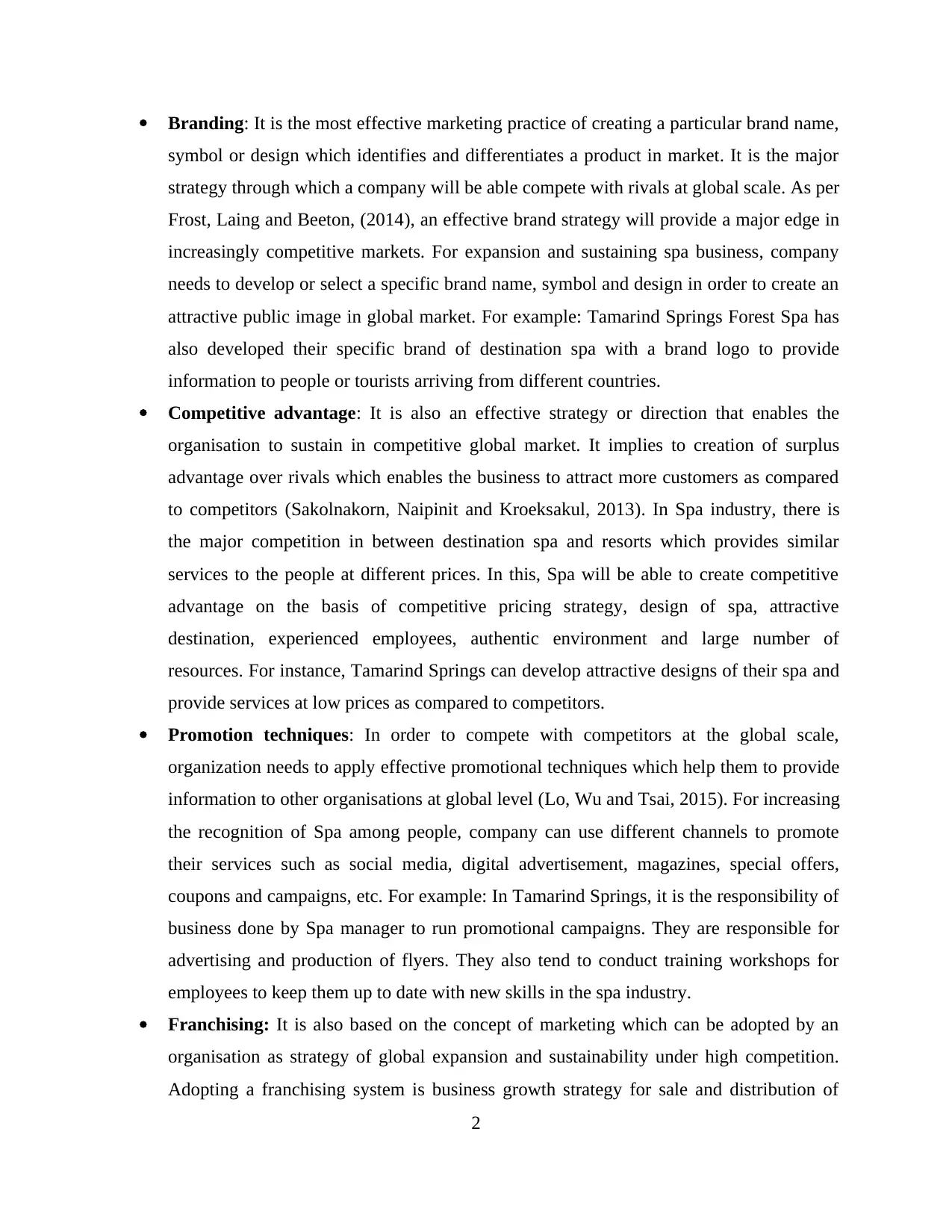
Branding: It is the most effective marketing practice of creating a particular brand name,
symbol or design which identifies and differentiates a product in market. It is the major
strategy through which a company will be able compete with rivals at global scale. As per
Frost, Laing and Beeton, (2014), an effective brand strategy will provide a major edge in
increasingly competitive markets. For expansion and sustaining spa business, company
needs to develop or select a specific brand name, symbol and design in order to create an
attractive public image in global market. For example: Tamarind Springs Forest Spa has
also developed their specific brand of destination spa with a brand logo to provide
information to people or tourists arriving from different countries.
Competitive advantage: It is also an effective strategy or direction that enables the
organisation to sustain in competitive global market. It implies to creation of surplus
advantage over rivals which enables the business to attract more customers as compared
to competitors (Sakolnakorn, Naipinit and Kroeksakul, 2013). In Spa industry, there is
the major competition in between destination spa and resorts which provides similar
services to the people at different prices. In this, Spa will be able to create competitive
advantage on the basis of competitive pricing strategy, design of spa, attractive
destination, experienced employees, authentic environment and large number of
resources. For instance, Tamarind Springs can develop attractive designs of their spa and
provide services at low prices as compared to competitors.
Promotion techniques: In order to compete with competitors at the global scale,
organization needs to apply effective promotional techniques which help them to provide
information to other organisations at global level (Lo, Wu and Tsai, 2015). For increasing
the recognition of Spa among people, company can use different channels to promote
their services such as social media, digital advertisement, magazines, special offers,
coupons and campaigns, etc. For example: In Tamarind Springs, it is the responsibility of
business done by Spa manager to run promotional campaigns. They are responsible for
advertising and production of flyers. They also tend to conduct training workshops for
employees to keep them up to date with new skills in the spa industry.
Franchising: It is also based on the concept of marketing which can be adopted by an
organisation as strategy of global expansion and sustainability under high competition.
Adopting a franchising system is business growth strategy for sale and distribution of
2
symbol or design which identifies and differentiates a product in market. It is the major
strategy through which a company will be able compete with rivals at global scale. As per
Frost, Laing and Beeton, (2014), an effective brand strategy will provide a major edge in
increasingly competitive markets. For expansion and sustaining spa business, company
needs to develop or select a specific brand name, symbol and design in order to create an
attractive public image in global market. For example: Tamarind Springs Forest Spa has
also developed their specific brand of destination spa with a brand logo to provide
information to people or tourists arriving from different countries.
Competitive advantage: It is also an effective strategy or direction that enables the
organisation to sustain in competitive global market. It implies to creation of surplus
advantage over rivals which enables the business to attract more customers as compared
to competitors (Sakolnakorn, Naipinit and Kroeksakul, 2013). In Spa industry, there is
the major competition in between destination spa and resorts which provides similar
services to the people at different prices. In this, Spa will be able to create competitive
advantage on the basis of competitive pricing strategy, design of spa, attractive
destination, experienced employees, authentic environment and large number of
resources. For instance, Tamarind Springs can develop attractive designs of their spa and
provide services at low prices as compared to competitors.
Promotion techniques: In order to compete with competitors at the global scale,
organization needs to apply effective promotional techniques which help them to provide
information to other organisations at global level (Lo, Wu and Tsai, 2015). For increasing
the recognition of Spa among people, company can use different channels to promote
their services such as social media, digital advertisement, magazines, special offers,
coupons and campaigns, etc. For example: In Tamarind Springs, it is the responsibility of
business done by Spa manager to run promotional campaigns. They are responsible for
advertising and production of flyers. They also tend to conduct training workshops for
employees to keep them up to date with new skills in the spa industry.
Franchising: It is also based on the concept of marketing which can be adopted by an
organisation as strategy of global expansion and sustainability under high competition.
Adopting a franchising system is business growth strategy for sale and distribution of
2
Paraphrase This Document
Need a fresh take? Get an instant paraphrase of this document with our AI Paraphraser
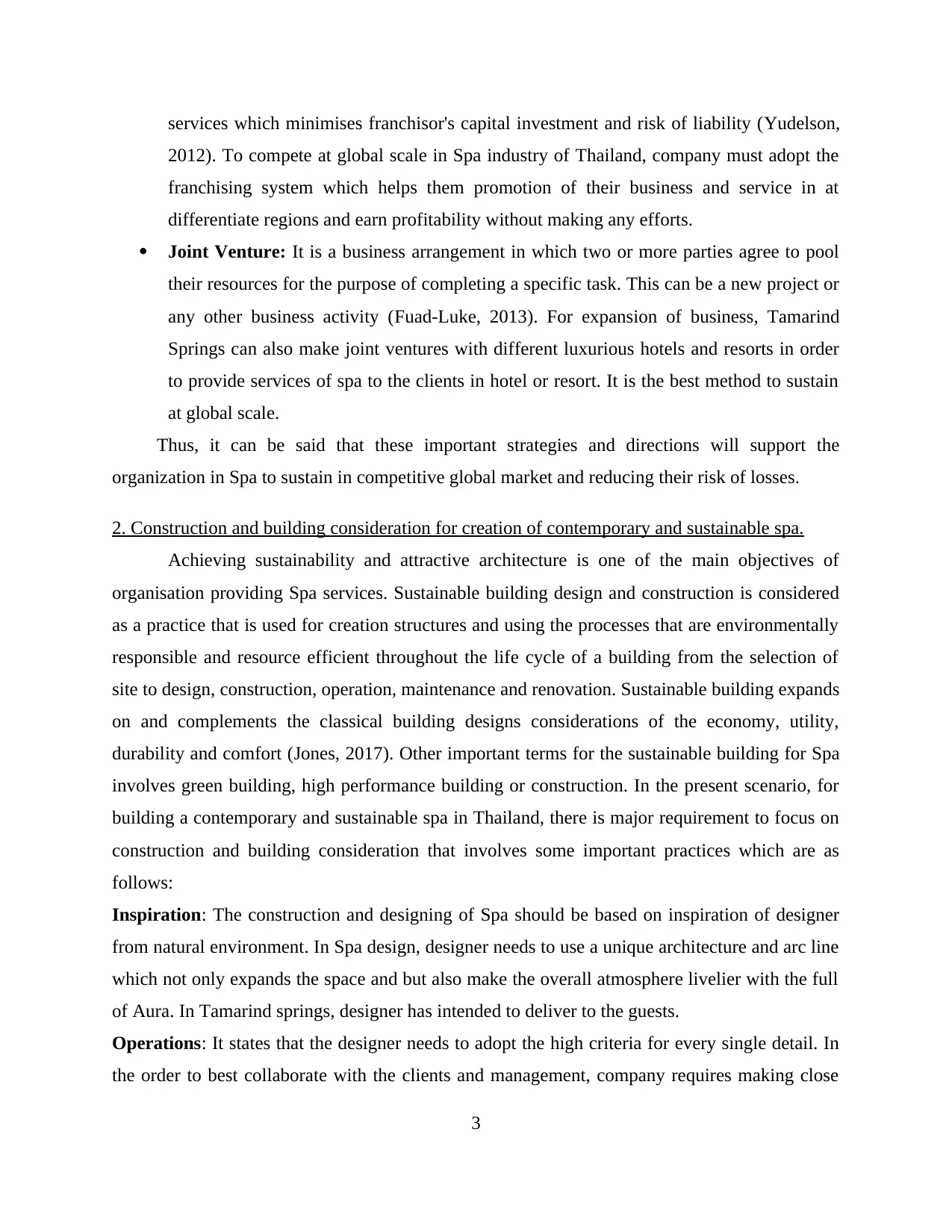
services which minimises franchisor's capital investment and risk of liability (Yudelson,
2012). To compete at global scale in Spa industry of Thailand, company must adopt the
franchising system which helps them promotion of their business and service in at
differentiate regions and earn profitability without making any efforts.
Joint Venture: It is a business arrangement in which two or more parties agree to pool
their resources for the purpose of completing a specific task. This can be a new project or
any other business activity (Fuad-Luke, 2013). For expansion of business, Tamarind
Springs can also make joint ventures with different luxurious hotels and resorts in order
to provide services of spa to the clients in hotel or resort. It is the best method to sustain
at global scale.
Thus, it can be said that these important strategies and directions will support the
organization in Spa to sustain in competitive global market and reducing their risk of losses.
2. Construction and building consideration for creation of contemporary and sustainable spa.
Achieving sustainability and attractive architecture is one of the main objectives of
organisation providing Spa services. Sustainable building design and construction is considered
as a practice that is used for creation structures and using the processes that are environmentally
responsible and resource efficient throughout the life cycle of a building from the selection of
site to design, construction, operation, maintenance and renovation. Sustainable building expands
on and complements the classical building designs considerations of the economy, utility,
durability and comfort (Jones, 2017). Other important terms for the sustainable building for Spa
involves green building, high performance building or construction. In the present scenario, for
building a contemporary and sustainable spa in Thailand, there is major requirement to focus on
construction and building consideration that involves some important practices which are as
follows:
Inspiration: The construction and designing of Spa should be based on inspiration of designer
from natural environment. In Spa design, designer needs to use a unique architecture and arc line
which not only expands the space and but also make the overall atmosphere livelier with the full
of Aura. In Tamarind springs, designer has intended to deliver to the guests.
Operations: It states that the designer needs to adopt the high criteria for every single detail. In
the order to best collaborate with the clients and management, company requires making close
3
2012). To compete at global scale in Spa industry of Thailand, company must adopt the
franchising system which helps them promotion of their business and service in at
differentiate regions and earn profitability without making any efforts.
Joint Venture: It is a business arrangement in which two or more parties agree to pool
their resources for the purpose of completing a specific task. This can be a new project or
any other business activity (Fuad-Luke, 2013). For expansion of business, Tamarind
Springs can also make joint ventures with different luxurious hotels and resorts in order
to provide services of spa to the clients in hotel or resort. It is the best method to sustain
at global scale.
Thus, it can be said that these important strategies and directions will support the
organization in Spa to sustain in competitive global market and reducing their risk of losses.
2. Construction and building consideration for creation of contemporary and sustainable spa.
Achieving sustainability and attractive architecture is one of the main objectives of
organisation providing Spa services. Sustainable building design and construction is considered
as a practice that is used for creation structures and using the processes that are environmentally
responsible and resource efficient throughout the life cycle of a building from the selection of
site to design, construction, operation, maintenance and renovation. Sustainable building expands
on and complements the classical building designs considerations of the economy, utility,
durability and comfort (Jones, 2017). Other important terms for the sustainable building for Spa
involves green building, high performance building or construction. In the present scenario, for
building a contemporary and sustainable spa in Thailand, there is major requirement to focus on
construction and building consideration that involves some important practices which are as
follows:
Inspiration: The construction and designing of Spa should be based on inspiration of designer
from natural environment. In Spa design, designer needs to use a unique architecture and arc line
which not only expands the space and but also make the overall atmosphere livelier with the full
of Aura. In Tamarind springs, designer has intended to deliver to the guests.
Operations: It states that the designer needs to adopt the high criteria for every single detail. In
the order to best collaborate with the clients and management, company requires making close
3
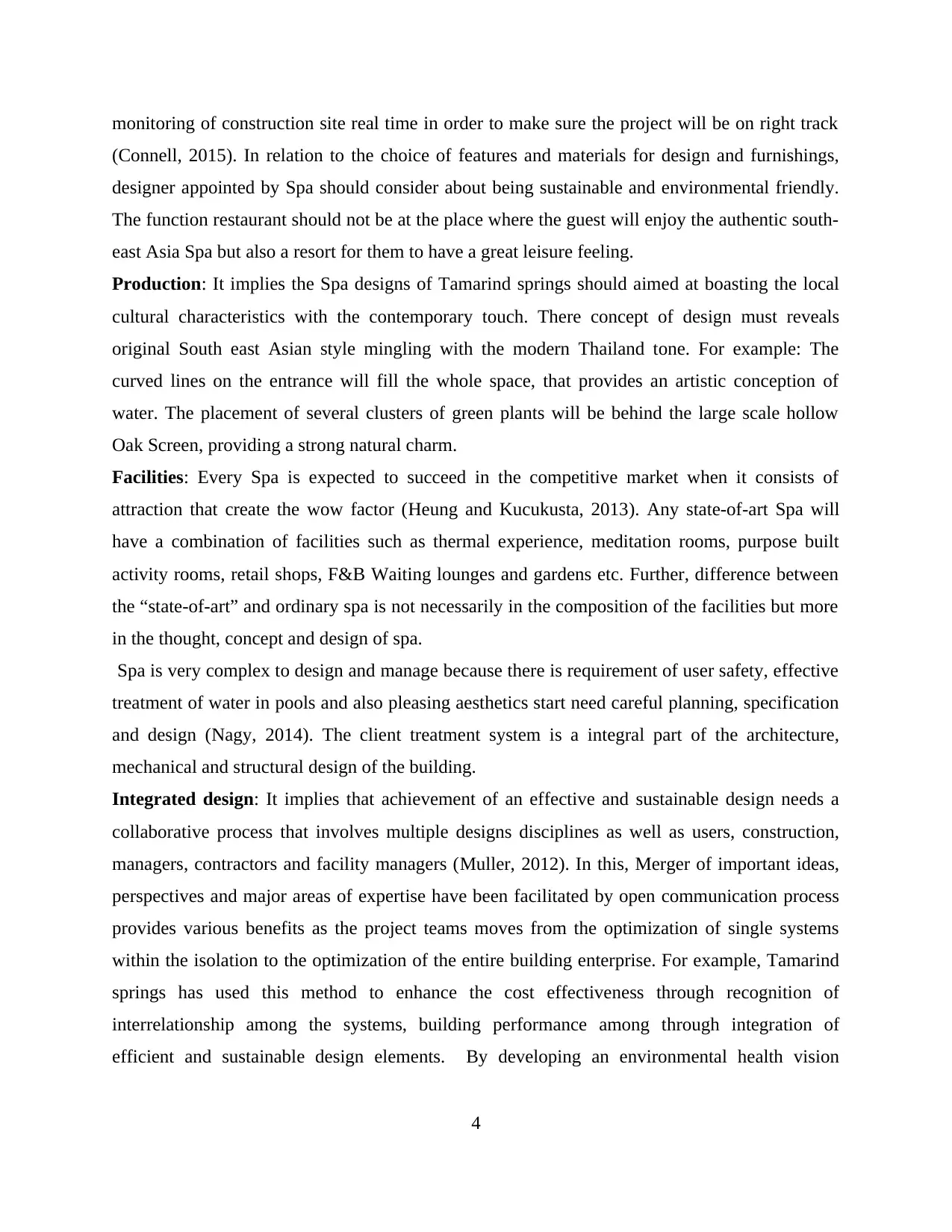
monitoring of construction site real time in order to make sure the project will be on right track
(Connell, 2015). In relation to the choice of features and materials for design and furnishings,
designer appointed by Spa should consider about being sustainable and environmental friendly.
The function restaurant should not be at the place where the guest will enjoy the authentic south-
east Asia Spa but also a resort for them to have a great leisure feeling.
Production: It implies the Spa designs of Tamarind springs should aimed at boasting the local
cultural characteristics with the contemporary touch. There concept of design must reveals
original South east Asian style mingling with the modern Thailand tone. For example: The
curved lines on the entrance will fill the whole space, that provides an artistic conception of
water. The placement of several clusters of green plants will be behind the large scale hollow
Oak Screen, providing a strong natural charm.
Facilities: Every Spa is expected to succeed in the competitive market when it consists of
attraction that create the wow factor (Heung and Kucukusta, 2013). Any state-of-art Spa will
have a combination of facilities such as thermal experience, meditation rooms, purpose built
activity rooms, retail shops, F&B Waiting lounges and gardens etc. Further, difference between
the “state-of-art” and ordinary spa is not necessarily in the composition of the facilities but more
in the thought, concept and design of spa.
Spa is very complex to design and manage because there is requirement of user safety, effective
treatment of water in pools and also pleasing aesthetics start need careful planning, specification
and design (Nagy, 2014). The client treatment system is a integral part of the architecture,
mechanical and structural design of the building.
Integrated design: It implies that achievement of an effective and sustainable design needs a
collaborative process that involves multiple designs disciplines as well as users, construction,
managers, contractors and facility managers (Muller, 2012). In this, Merger of important ideas,
perspectives and major areas of expertise have been facilitated by open communication process
provides various benefits as the project teams moves from the optimization of single systems
within the isolation to the optimization of the entire building enterprise. For example, Tamarind
springs has used this method to enhance the cost effectiveness through recognition of
interrelationship among the systems, building performance among through integration of
efficient and sustainable design elements. By developing an environmental health vision
4
(Connell, 2015). In relation to the choice of features and materials for design and furnishings,
designer appointed by Spa should consider about being sustainable and environmental friendly.
The function restaurant should not be at the place where the guest will enjoy the authentic south-
east Asia Spa but also a resort for them to have a great leisure feeling.
Production: It implies the Spa designs of Tamarind springs should aimed at boasting the local
cultural characteristics with the contemporary touch. There concept of design must reveals
original South east Asian style mingling with the modern Thailand tone. For example: The
curved lines on the entrance will fill the whole space, that provides an artistic conception of
water. The placement of several clusters of green plants will be behind the large scale hollow
Oak Screen, providing a strong natural charm.
Facilities: Every Spa is expected to succeed in the competitive market when it consists of
attraction that create the wow factor (Heung and Kucukusta, 2013). Any state-of-art Spa will
have a combination of facilities such as thermal experience, meditation rooms, purpose built
activity rooms, retail shops, F&B Waiting lounges and gardens etc. Further, difference between
the “state-of-art” and ordinary spa is not necessarily in the composition of the facilities but more
in the thought, concept and design of spa.
Spa is very complex to design and manage because there is requirement of user safety, effective
treatment of water in pools and also pleasing aesthetics start need careful planning, specification
and design (Nagy, 2014). The client treatment system is a integral part of the architecture,
mechanical and structural design of the building.
Integrated design: It implies that achievement of an effective and sustainable design needs a
collaborative process that involves multiple designs disciplines as well as users, construction,
managers, contractors and facility managers (Muller, 2012). In this, Merger of important ideas,
perspectives and major areas of expertise have been facilitated by open communication process
provides various benefits as the project teams moves from the optimization of single systems
within the isolation to the optimization of the entire building enterprise. For example, Tamarind
springs has used this method to enhance the cost effectiveness through recognition of
interrelationship among the systems, building performance among through integration of
efficient and sustainable design elements. By developing an environmental health vision
4
⊘ This is a preview!⊘
Do you want full access?
Subscribe today to unlock all pages.

Trusted by 1+ million students worldwide
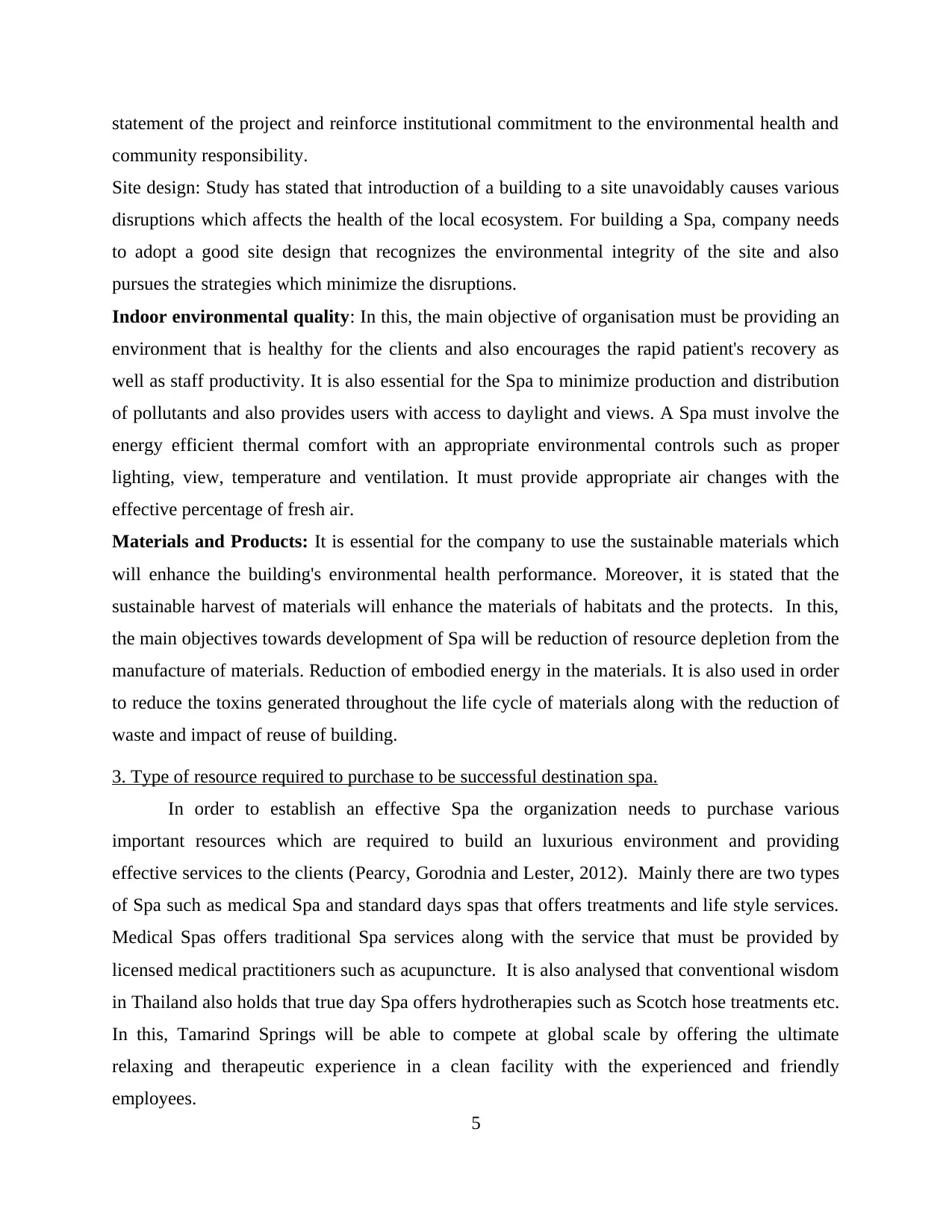
statement of the project and reinforce institutional commitment to the environmental health and
community responsibility.
Site design: Study has stated that introduction of a building to a site unavoidably causes various
disruptions which affects the health of the local ecosystem. For building a Spa, company needs
to adopt a good site design that recognizes the environmental integrity of the site and also
pursues the strategies which minimize the disruptions.
Indoor environmental quality: In this, the main objective of organisation must be providing an
environment that is healthy for the clients and also encourages the rapid patient's recovery as
well as staff productivity. It is also essential for the Spa to minimize production and distribution
of pollutants and also provides users with access to daylight and views. A Spa must involve the
energy efficient thermal comfort with an appropriate environmental controls such as proper
lighting, view, temperature and ventilation. It must provide appropriate air changes with the
effective percentage of fresh air.
Materials and Products: It is essential for the company to use the sustainable materials which
will enhance the building's environmental health performance. Moreover, it is stated that the
sustainable harvest of materials will enhance the materials of habitats and the protects. In this,
the main objectives towards development of Spa will be reduction of resource depletion from the
manufacture of materials. Reduction of embodied energy in the materials. It is also used in order
to reduce the toxins generated throughout the life cycle of materials along with the reduction of
waste and impact of reuse of building.
3. Type of resource required to purchase to be successful destination spa.
In order to establish an effective Spa the organization needs to purchase various
important resources which are required to build an luxurious environment and providing
effective services to the clients (Pearcy, Gorodnia and Lester, 2012). Mainly there are two types
of Spa such as medical Spa and standard days spas that offers treatments and life style services.
Medical Spas offers traditional Spa services along with the service that must be provided by
licensed medical practitioners such as acupuncture. It is also analysed that conventional wisdom
in Thailand also holds that true day Spa offers hydrotherapies such as Scotch hose treatments etc.
In this, Tamarind Springs will be able to compete at global scale by offering the ultimate
relaxing and therapeutic experience in a clean facility with the experienced and friendly
employees.
5
community responsibility.
Site design: Study has stated that introduction of a building to a site unavoidably causes various
disruptions which affects the health of the local ecosystem. For building a Spa, company needs
to adopt a good site design that recognizes the environmental integrity of the site and also
pursues the strategies which minimize the disruptions.
Indoor environmental quality: In this, the main objective of organisation must be providing an
environment that is healthy for the clients and also encourages the rapid patient's recovery as
well as staff productivity. It is also essential for the Spa to minimize production and distribution
of pollutants and also provides users with access to daylight and views. A Spa must involve the
energy efficient thermal comfort with an appropriate environmental controls such as proper
lighting, view, temperature and ventilation. It must provide appropriate air changes with the
effective percentage of fresh air.
Materials and Products: It is essential for the company to use the sustainable materials which
will enhance the building's environmental health performance. Moreover, it is stated that the
sustainable harvest of materials will enhance the materials of habitats and the protects. In this,
the main objectives towards development of Spa will be reduction of resource depletion from the
manufacture of materials. Reduction of embodied energy in the materials. It is also used in order
to reduce the toxins generated throughout the life cycle of materials along with the reduction of
waste and impact of reuse of building.
3. Type of resource required to purchase to be successful destination spa.
In order to establish an effective Spa the organization needs to purchase various
important resources which are required to build an luxurious environment and providing
effective services to the clients (Pearcy, Gorodnia and Lester, 2012). Mainly there are two types
of Spa such as medical Spa and standard days spas that offers treatments and life style services.
Medical Spas offers traditional Spa services along with the service that must be provided by
licensed medical practitioners such as acupuncture. It is also analysed that conventional wisdom
in Thailand also holds that true day Spa offers hydrotherapies such as Scotch hose treatments etc.
In this, Tamarind Springs will be able to compete at global scale by offering the ultimate
relaxing and therapeutic experience in a clean facility with the experienced and friendly
employees.
5
Paraphrase This Document
Need a fresh take? Get an instant paraphrase of this document with our AI Paraphraser
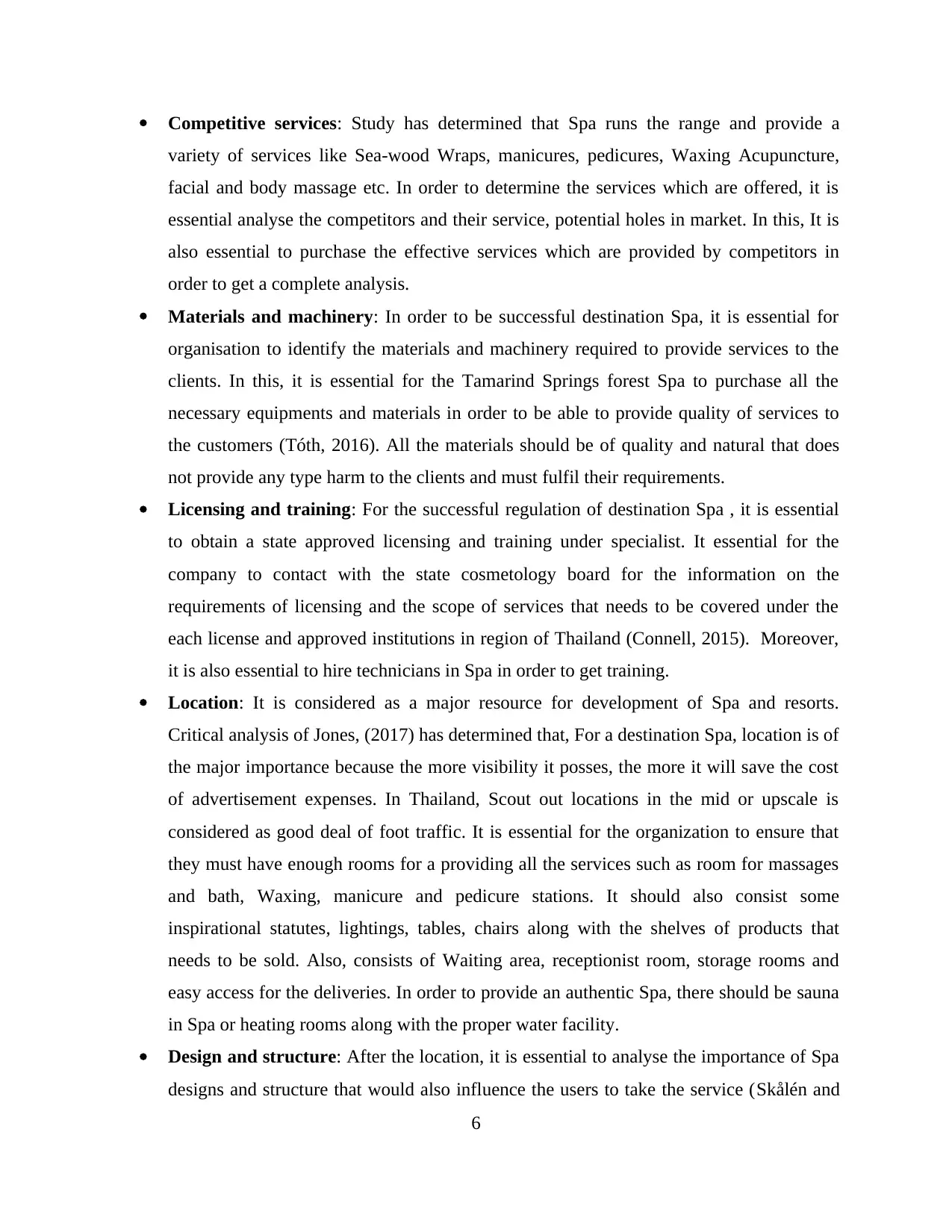
Competitive services: Study has determined that Spa runs the range and provide a
variety of services like Sea-wood Wraps, manicures, pedicures, Waxing Acupuncture,
facial and body massage etc. In order to determine the services which are offered, it is
essential analyse the competitors and their service, potential holes in market. In this, It is
also essential to purchase the effective services which are provided by competitors in
order to get a complete analysis.
Materials and machinery: In order to be successful destination Spa, it is essential for
organisation to identify the materials and machinery required to provide services to the
clients. In this, it is essential for the Tamarind Springs forest Spa to purchase all the
necessary equipments and materials in order to be able to provide quality of services to
the customers (Tóth, 2016). All the materials should be of quality and natural that does
not provide any type harm to the clients and must fulfil their requirements.
Licensing and training: For the successful regulation of destination Spa , it is essential
to obtain a state approved licensing and training under specialist. It essential for the
company to contact with the state cosmetology board for the information on the
requirements of licensing and the scope of services that needs to be covered under the
each license and approved institutions in region of Thailand (Connell, 2015). Moreover,
it is also essential to hire technicians in Spa in order to get training.
Location: It is considered as a major resource for development of Spa and resorts.
Critical analysis of Jones, (2017) has determined that, For a destination Spa, location is of
the major importance because the more visibility it posses, the more it will save the cost
of advertisement expenses. In Thailand, Scout out locations in the mid or upscale is
considered as good deal of foot traffic. It is essential for the organization to ensure that
they must have enough rooms for a providing all the services such as room for massages
and bath, Waxing, manicure and pedicure stations. It should also consist some
inspirational statutes, lightings, tables, chairs along with the shelves of products that
needs to be sold. Also, consists of Waiting area, receptionist room, storage rooms and
easy access for the deliveries. In order to provide an authentic Spa, there should be sauna
in Spa or heating rooms along with the proper water facility.
Design and structure: After the location, it is essential to analyse the importance of Spa
designs and structure that would also influence the users to take the service (Skålén and
6
variety of services like Sea-wood Wraps, manicures, pedicures, Waxing Acupuncture,
facial and body massage etc. In order to determine the services which are offered, it is
essential analyse the competitors and their service, potential holes in market. In this, It is
also essential to purchase the effective services which are provided by competitors in
order to get a complete analysis.
Materials and machinery: In order to be successful destination Spa, it is essential for
organisation to identify the materials and machinery required to provide services to the
clients. In this, it is essential for the Tamarind Springs forest Spa to purchase all the
necessary equipments and materials in order to be able to provide quality of services to
the customers (Tóth, 2016). All the materials should be of quality and natural that does
not provide any type harm to the clients and must fulfil their requirements.
Licensing and training: For the successful regulation of destination Spa , it is essential
to obtain a state approved licensing and training under specialist. It essential for the
company to contact with the state cosmetology board for the information on the
requirements of licensing and the scope of services that needs to be covered under the
each license and approved institutions in region of Thailand (Connell, 2015). Moreover,
it is also essential to hire technicians in Spa in order to get training.
Location: It is considered as a major resource for development of Spa and resorts.
Critical analysis of Jones, (2017) has determined that, For a destination Spa, location is of
the major importance because the more visibility it posses, the more it will save the cost
of advertisement expenses. In Thailand, Scout out locations in the mid or upscale is
considered as good deal of foot traffic. It is essential for the organization to ensure that
they must have enough rooms for a providing all the services such as room for massages
and bath, Waxing, manicure and pedicure stations. It should also consist some
inspirational statutes, lightings, tables, chairs along with the shelves of products that
needs to be sold. Also, consists of Waiting area, receptionist room, storage rooms and
easy access for the deliveries. In order to provide an authentic Spa, there should be sauna
in Spa or heating rooms along with the proper water facility.
Design and structure: After the location, it is essential to analyse the importance of Spa
designs and structure that would also influence the users to take the service (Skålén and
6
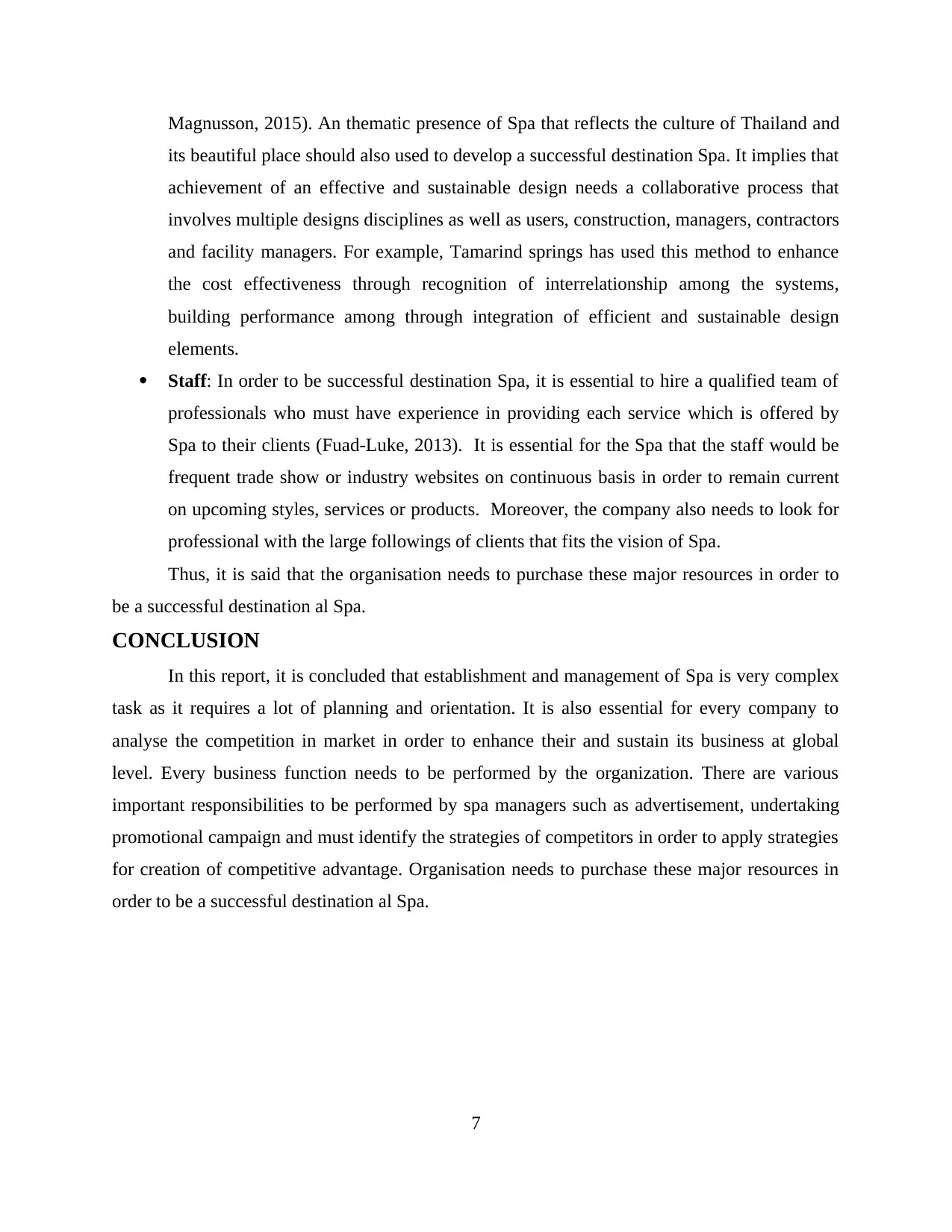
Magnusson, 2015). An thematic presence of Spa that reflects the culture of Thailand and
its beautiful place should also used to develop a successful destination Spa. It implies that
achievement of an effective and sustainable design needs a collaborative process that
involves multiple designs disciplines as well as users, construction, managers, contractors
and facility managers. For example, Tamarind springs has used this method to enhance
the cost effectiveness through recognition of interrelationship among the systems,
building performance among through integration of efficient and sustainable design
elements.
Staff: In order to be successful destination Spa, it is essential to hire a qualified team of
professionals who must have experience in providing each service which is offered by
Spa to their clients (Fuad-Luke, 2013). It is essential for the Spa that the staff would be
frequent trade show or industry websites on continuous basis in order to remain current
on upcoming styles, services or products. Moreover, the company also needs to look for
professional with the large followings of clients that fits the vision of Spa.
Thus, it is said that the organisation needs to purchase these major resources in order to
be a successful destination al Spa.
CONCLUSION
In this report, it is concluded that establishment and management of Spa is very complex
task as it requires a lot of planning and orientation. It is also essential for every company to
analyse the competition in market in order to enhance their and sustain its business at global
level. Every business function needs to be performed by the organization. There are various
important responsibilities to be performed by spa managers such as advertisement, undertaking
promotional campaign and must identify the strategies of competitors in order to apply strategies
for creation of competitive advantage. Organisation needs to purchase these major resources in
order to be a successful destination al Spa.
7
its beautiful place should also used to develop a successful destination Spa. It implies that
achievement of an effective and sustainable design needs a collaborative process that
involves multiple designs disciplines as well as users, construction, managers, contractors
and facility managers. For example, Tamarind springs has used this method to enhance
the cost effectiveness through recognition of interrelationship among the systems,
building performance among through integration of efficient and sustainable design
elements.
Staff: In order to be successful destination Spa, it is essential to hire a qualified team of
professionals who must have experience in providing each service which is offered by
Spa to their clients (Fuad-Luke, 2013). It is essential for the Spa that the staff would be
frequent trade show or industry websites on continuous basis in order to remain current
on upcoming styles, services or products. Moreover, the company also needs to look for
professional with the large followings of clients that fits the vision of Spa.
Thus, it is said that the organisation needs to purchase these major resources in order to
be a successful destination al Spa.
CONCLUSION
In this report, it is concluded that establishment and management of Spa is very complex
task as it requires a lot of planning and orientation. It is also essential for every company to
analyse the competition in market in order to enhance their and sustain its business at global
level. Every business function needs to be performed by the organization. There are various
important responsibilities to be performed by spa managers such as advertisement, undertaking
promotional campaign and must identify the strategies of competitors in order to apply strategies
for creation of competitive advantage. Organisation needs to purchase these major resources in
order to be a successful destination al Spa.
7
⊘ This is a preview!⊘
Do you want full access?
Subscribe today to unlock all pages.

Trusted by 1+ million students worldwide
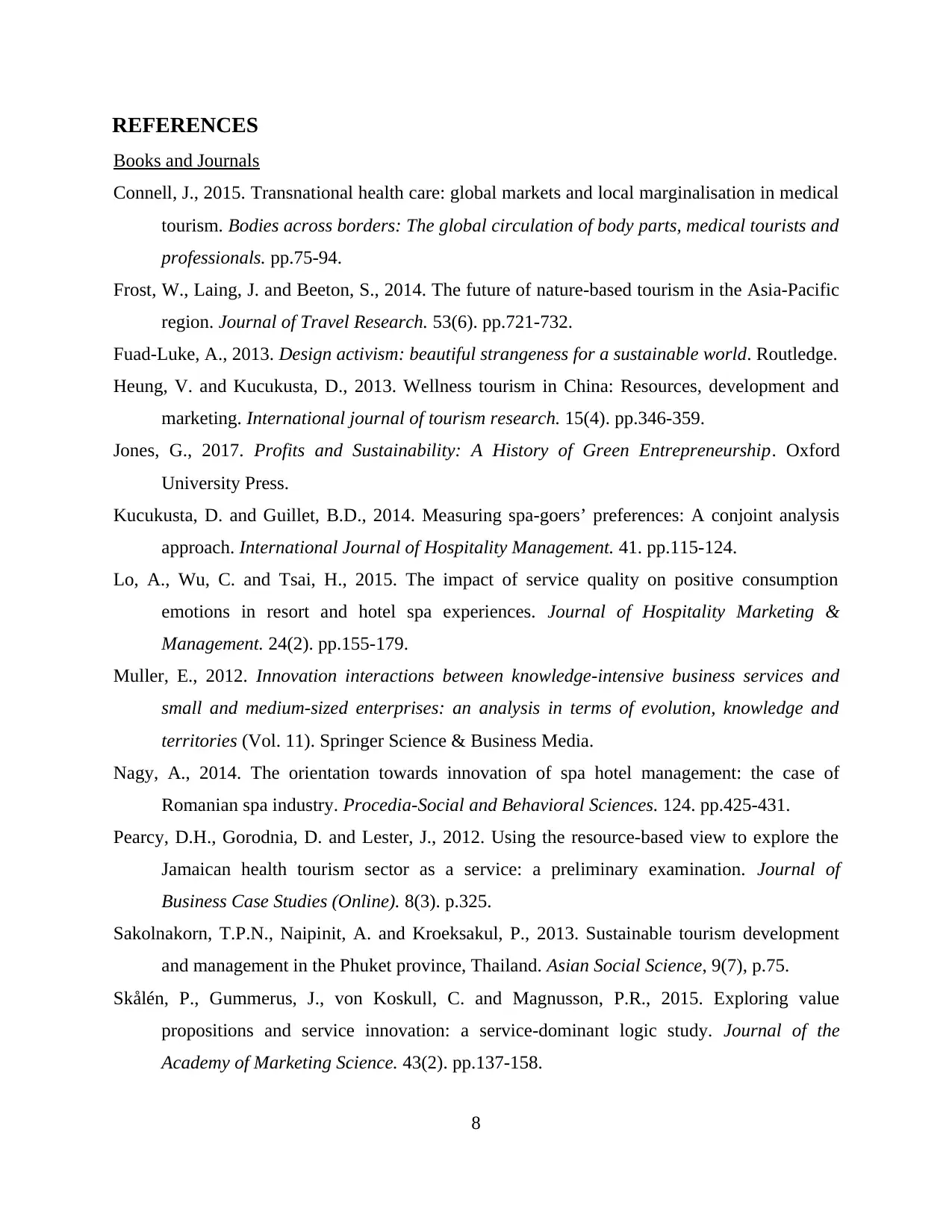
REFERENCES
Books and Journals
Connell, J., 2015. Transnational health care: global markets and local marginalisation in medical
tourism. Bodies across borders: The global circulation of body parts, medical tourists and
professionals. pp.75-94.
Frost, W., Laing, J. and Beeton, S., 2014. The future of nature-based tourism in the Asia-Pacific
region. Journal of Travel Research. 53(6). pp.721-732.
Fuad-Luke, A., 2013. Design activism: beautiful strangeness for a sustainable world. Routledge.
Heung, V. and Kucukusta, D., 2013. Wellness tourism in China: Resources, development and
marketing. International journal of tourism research. 15(4). pp.346-359.
Jones, G., 2017. Profits and Sustainability: A History of Green Entrepreneurship. Oxford
University Press.
Kucukusta, D. and Guillet, B.D., 2014. Measuring spa-goers’ preferences: A conjoint analysis
approach. International Journal of Hospitality Management. 41. pp.115-124.
Lo, A., Wu, C. and Tsai, H., 2015. The impact of service quality on positive consumption
emotions in resort and hotel spa experiences. Journal of Hospitality Marketing &
Management. 24(2). pp.155-179.
Muller, E., 2012. Innovation interactions between knowledge-intensive business services and
small and medium-sized enterprises: an analysis in terms of evolution, knowledge and
territories (Vol. 11). Springer Science & Business Media.
Nagy, A., 2014. The orientation towards innovation of spa hotel management: the case of
Romanian spa industry. Procedia-Social and Behavioral Sciences. 124. pp.425-431.
Pearcy, D.H., Gorodnia, D. and Lester, J., 2012. Using the resource-based view to explore the
Jamaican health tourism sector as a service: a preliminary examination. Journal of
Business Case Studies (Online). 8(3). p.325.
Sakolnakorn, T.P.N., Naipinit, A. and Kroeksakul, P., 2013. Sustainable tourism development
and management in the Phuket province, Thailand. Asian Social Science, 9(7), p.75.
Skålén, P., Gummerus, J., von Koskull, C. and Magnusson, P.R., 2015. Exploring value
propositions and service innovation: a service-dominant logic study. Journal of the
Academy of Marketing Science. 43(2). pp.137-158.
8
Books and Journals
Connell, J., 2015. Transnational health care: global markets and local marginalisation in medical
tourism. Bodies across borders: The global circulation of body parts, medical tourists and
professionals. pp.75-94.
Frost, W., Laing, J. and Beeton, S., 2014. The future of nature-based tourism in the Asia-Pacific
region. Journal of Travel Research. 53(6). pp.721-732.
Fuad-Luke, A., 2013. Design activism: beautiful strangeness for a sustainable world. Routledge.
Heung, V. and Kucukusta, D., 2013. Wellness tourism in China: Resources, development and
marketing. International journal of tourism research. 15(4). pp.346-359.
Jones, G., 2017. Profits and Sustainability: A History of Green Entrepreneurship. Oxford
University Press.
Kucukusta, D. and Guillet, B.D., 2014. Measuring spa-goers’ preferences: A conjoint analysis
approach. International Journal of Hospitality Management. 41. pp.115-124.
Lo, A., Wu, C. and Tsai, H., 2015. The impact of service quality on positive consumption
emotions in resort and hotel spa experiences. Journal of Hospitality Marketing &
Management. 24(2). pp.155-179.
Muller, E., 2012. Innovation interactions between knowledge-intensive business services and
small and medium-sized enterprises: an analysis in terms of evolution, knowledge and
territories (Vol. 11). Springer Science & Business Media.
Nagy, A., 2014. The orientation towards innovation of spa hotel management: the case of
Romanian spa industry. Procedia-Social and Behavioral Sciences. 124. pp.425-431.
Pearcy, D.H., Gorodnia, D. and Lester, J., 2012. Using the resource-based view to explore the
Jamaican health tourism sector as a service: a preliminary examination. Journal of
Business Case Studies (Online). 8(3). p.325.
Sakolnakorn, T.P.N., Naipinit, A. and Kroeksakul, P., 2013. Sustainable tourism development
and management in the Phuket province, Thailand. Asian Social Science, 9(7), p.75.
Skålén, P., Gummerus, J., von Koskull, C. and Magnusson, P.R., 2015. Exploring value
propositions and service innovation: a service-dominant logic study. Journal of the
Academy of Marketing Science. 43(2). pp.137-158.
8
Paraphrase This Document
Need a fresh take? Get an instant paraphrase of this document with our AI Paraphraser

Tóth, A.A., 2016. The importance of Spa and Wellness Hotels in leisure destinations in
Hungary. International Leisure Review. 5(2). pp.3-29.
Yudelson, J., 2012. Green building trends: Europe. Island Press.
9
Hungary. International Leisure Review. 5(2). pp.3-29.
Yudelson, J., 2012. Green building trends: Europe. Island Press.
9
1 out of 11
Related Documents
Your All-in-One AI-Powered Toolkit for Academic Success.
+13062052269
info@desklib.com
Available 24*7 on WhatsApp / Email
![[object Object]](/_next/static/media/star-bottom.7253800d.svg)
Unlock your academic potential
Copyright © 2020–2025 A2Z Services. All Rights Reserved. Developed and managed by ZUCOL.





